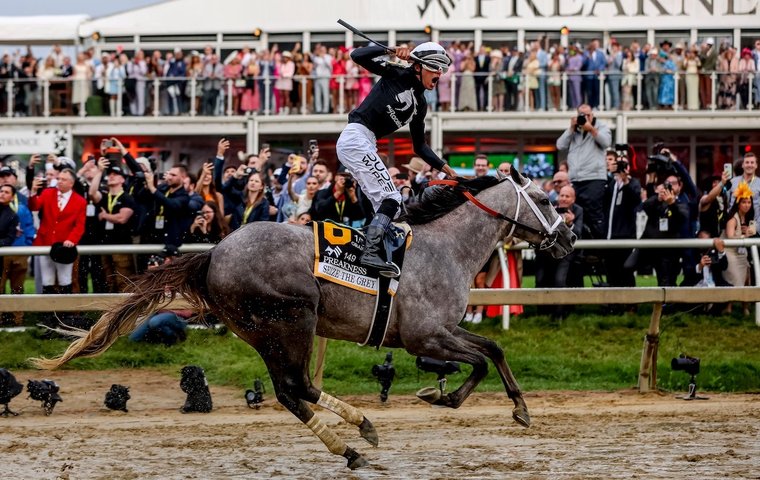
Our correspondent has had plenty of luck as a microshare owner. All of it bad, as he tells us here
 I am not a ‘micro-maniac’, but I have bitten the bullet on microshares in four horses from two of the eight companies offering them, suffering only a relative ‘micro-bite’ into my wallet. Did I lose money? We’ll get to that.
I am not a ‘micro-maniac’, but I have bitten the bullet on microshares in four horses from two of the eight companies offering them, suffering only a relative ‘micro-bite’ into my wallet. Did I lose money? We’ll get to that.
The reason for getting into microshares has been decades in the making. First off, I finally spit the proverbial bit with handicapping. A man’s got to know his limitations, according to Clint Eastwood, which is wisdom that only took, oh, 40-plus years to learn.
I tell you straight up that microshares are a helluva lot more fun than losing bets at the racetrack. To express it another way, losing money on a microshare, even if it is a pittance, holds your attention and actually becomes a hobby. There is always tomorrow with ‘your’ horse.
In fact, all those tomorrows can spread across months and possibly a couple of years, full of races and nifty updates. At the racetrack, your bets – a kind of investment, if you think about it – span the time it takes to run a race and tear in twain your ticket. That was the drill for me, anyway.
I won’t name the horses in which I invested, as it might throw shade on the microshare merchants. You pays your money and you takes your choice, as the old saying goes.
The process puts me in mind of a quote for a story I got from this year’s Kentucky Derby-winning trainer Kenny McPeek on new horses coming to him each year, that tends to parallel my experience with my four horses.
“One refuses to run,” he said. “One can’t run. One gets hurt. One’s a nice horse you have a little bit of fun with. And one’s a really nice horse that helps you forget the first four.”
At least I checked the boxes of the first three.
Triple Crown pedigree
My first horse had the pedigree of a Triple Crown winner and the performance of a $4,000 claimer, which is exactly what he was when his career ended with his 18th start. It happens.
He started out fetching a price of $165,000 at auction as a weanling and $200,000 the next year in a yearling sale. His next appearance in the ring gave an inkling that maybe he was not going to live up to his pedigree. In a two-year-old/horses of racing age sale he sold for just over $70,000.
No, he wasn’t going to be a stakes winner or even a stakes runner, but no-one foresaw $4,000 claiming races either. He went from promise to pfft. Again, it happens. Perhaps fittingly, on his final start he finished last.
He was a trier, though. On his 16th start he broke his maiden for the lone win in a brief but busy career lasting 19 months. Of course, that was after leaving my stable. I’ll add, with a certain amount of snideness and sarcasm as I get into my other horses, at least he made it between the rails.
The latest word on my second buy is that he was hoping to not hit rails in the showjumping world. He fits McPeek’s first category: refusing to run.
Throwing exercise riders repeatedly was his forté, and gelding him, which I thought was foolproof, did absolutely nothing for his temperament. There was even a story of orneriness while travelling between the track and the barn before and after what little working out he did before throwing his rider du jour.
He did provide, however, the best laugh I ever had connected to horses and racing. The microshare firm sent out an update with a video of a group of owners coming to see him at the farm where an expert attempted to train him.
Vast potential
As the trainer was extolling the vast potential of this beast to the owners, in the background you could see a groom struggling to hold on for dear life to my horse’s shank as he reared, bucked, and acted a complete fool.
The farm trainer never lost his cool, braving what was going on behind him to continue his update and the tour. It would have been bad form to quickly hustle the group out of the paddock to safety, or worse, run for his life.
I laughed till I cried, even though he was partly my horse. I told a friend of mine from the racetrack who didn’t even see the video, and he laughed till he cried too. I can’t remember what I paid for the share in that horse, but that video was worth every penny of the cost.
As everyone knows, things come in threes. Yep, no good with the third horse too. I’ll spare you the gory details except one: on his first start he earned an Equibase Speed Figure of 10, a great number for an actress in a swimsuit but not for a racehorse.
He improved (how could he not?) in two more starts, even finishing third in what turned out to be his last race. He was retired after not responding to therapy for a condition that typically cuts racing careers short. That happens too.
Things had to change
With my fourth horse I had to think, in a perfect world where wins and losses equal out, things had to change. Nope. He never ran.
I won’t ask for pity, mainly because it won’t stop people marveling at how anyone could have this kind of luck.
It’s not easy, though, to overcome the jealousy about the umpteen thousand microshare brethren who hit with a Derby and a Preakness winner. Actually, their success is so diametrically the opposite of my record, I marvel at their luck and am happy for them.
I took a break for nine months from microshares (who wouldn’t?) before restoration of my faith in the natural order of things. It had to get better as, obviously, it couldn’t get any worse.
Eastwood’s limitations may not extend to this fifth horse and maybe a sixth, seventh or eighth horse. Hope springs eternal, and my latest hope is a beautiful gray two-year-old who will run on the circuit in my area of the country.
Oh yeah, the question of whether I lost money. I’ll postpone the answer until after my new horse dusts off the competition on his way to a Graded stakes win. It happens.
• View previous articles in our View from the Rail series
All-Star interview: how racing became a major-league attraction for Jayson Werth
View the latest TRC Global Rankings for horses / jockeys / trainers / sires


